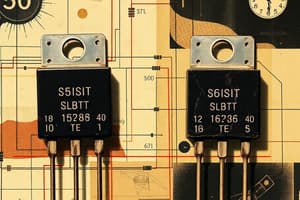Podcast
Questions and Answers
Classify different types of FETs and provide one key feature of each type.
Classify different types of FETs and provide one key feature of each type.
The main types of FETs are Junction FET (JFET), Metal-Oxide-Semiconductor FET (MOSFET), and Insulated Gate Bipolar Transistor (IGBT). JFETs have a low noise operation, MOSFETs provide high input impedance, and IGBTs combine the advantages of both BJTs and MOSFETs.
What is the role of the Source, Drain, and Gate in a FET?
What is the role of the Source, Drain, and Gate in a FET?
The Source is the terminal where carriers enter the device, the Drain is where they exit, and the Gate controls the flow of carriers between the Source and Drain. This gating effect allows for the FET’s amplifying and switching capabilities.
Compare JFET and MOSFET in terms of structure and operational principles.
Compare JFET and MOSFET in terms of structure and operational principles.
JFETs have a simpler structure, using a p-n junction, while MOSFETs utilize an insulating layer and have a gate that is capacitively coupled. MOSFETs offer higher input impedance and better scalability for modern applications.
List the advantages of FET over BJT.
List the advantages of FET over BJT.
Define stability factor and its importance in amplifier design.
Define stability factor and its importance in amplifier design.
Flashcards are hidden until you start studying
Study Notes
FET Classification and Components
- FETs are classified into types: JFET (Junction FET) and MOSFET (Metal-Oxide-Semiconductor FET).
- Key components of FETs include the Source (S), Drain (D), and Gate (G).
- The Source terminal supplies carriers, the Drain terminal collects carriers, and the Gate controls the flow of carriers.
JFET Applications and Characteristics
- JFETs are commonly used in amplifiers, analog switches, and voltage-controlled resistors.
- Key comparisons: JFET has high input impedance; BJT (Bipolar Junction Transistor) has lower input impedance.
Performance and Stability
- Pinch-off voltage occurs when the drain-source voltage is sufficient to create a depletion region, effectively limiting the current.
- Stability factors are critical in ensuring consistent amplifier operation, defining how parameters shift with temperature.
Amplifier Fundamentals
- Gain refers to the ratio of output to input signal strength, while frequency response describes the operational bandwidth of an amplifier.
- Common-emitter (CE) amplifiers are favored for their high gain and wide frequency response.
Power Amplifiers and Heat Management
- Power amplifiers are classified by conduction period: Class A, B, AB, and C, each with distinct operational efficiencies.
- Heat sinks are essential for thermal management, preventing component overheating.
Oscillator Principles
- An oscillator generates a periodic signal; conditions for operation include feedback and proper gain.
- Barkhausen criteria ascertain the necessary conditions for sustained oscillations.
Varactor Diodes and LCD Technology
- Varactor diodes are voltage-dependent capacitors used in RF circuits for tuning.
- LCDs (Liquid Crystal Displays) function by manipulating light using liquid crystals, with various types for different applications.
Solar Technology and Photodetection
- Photovoltaic cells convert light to electricity, commonly used in solar power systems.
- Photodiodes and phototransistors are critical for light detection in various devices; they convert light signals into electrical signals.
Circuit Analysis
- AC load line determines the relationship between AC voltage and current in amplifiers while DC load line represents the steady-state operation point.
- Biasing ensures transistors operate in the desired region, with methods like potential divider and collector-base resistor each having strengths and weaknesses.
Advantages of FETs
- FETs have advantages over BJTs, including higher input impedance, lower noise, and better thermal stability.
Amplifier Classes and Feedback Mechanisms
- Class A provides linear amplification but with lower efficiency; Classes B and AB improve efficiency while maintaining acceptable linearity.
- Feedback mechanisms, positive and negative, play vital roles in stabilizing gain and enhancing bandwidth.
Key Oscillator Types
- RC phase shift, Colpitts, and Hartley oscillators each use distinct configurations to generate oscillatory signals.
- Crystal oscillators benefit from frequency stability and precision, often used in timing applications.
Photodiode Characteristics and LED Operation
- Photodiodes typically exhibit current-voltage (I-V) characteristics responsive to light intensity.
- LEDs operate by electroluminescence, converting electrical energy directly into light.
Overall Understanding
- Familiarity with these concepts is crucial for working with electronic devices, amplifiers, and oscillators in various applications, including consumer electronics, communication systems, and power management.
Studying That Suits You
Use AI to generate personalized quizzes and flashcards to suit your learning preferences.




